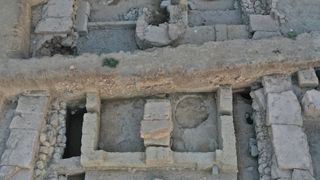
An aerial view of the horseshoe-shaped altar located inside the temple. (Image credit: Ministry of Culture via Facebook)
Archaeologists in Greece have discovered a 2,700-year-old temple that houses a horseshoe-shaped altar overflowing with offerings.
Constructed of bricks, the temple is 100 feet (30 meters) long and is located next to the Temple of Amarysia Artemis, a sanctuary dedicated to the Greek goddess Artemis, which researchers found in 2017 on the island of Evia, according to a translated statement from Greece’s Ministry of Culture.
During excavations in 2023, archaeologists found the second temple.
Related: 2,800-year-old figurines unearthed at Greek temple may be offerings to Poseidon
“One of the peculiarities of this temple is the significant number of structures found inside it,” the researchers wrote on Jan. 9 in a translated Facebook post detailing their finding.
Those structures included several hearths located in the temple’s nave, including the ash-caked altar stacked with offerings such as pottery; vases; Corinthian alabaster, or the carved mineral gypsum; gold and silver jewelry studded with coral and amber; amulets; and bronze and iron fittings. The altar also contained several pieces of charred bone.
Some of the pottery pieces predate the newfound temple and were fired during the late eighth century B.C., leading researchers to suspect that the altar may have once resided outside the temple and was later moved indoors.
In the sixth century B.C., brick partitions were placed at the sanctuary’s heart for added support, leading researchers to think that the temple was “partially destroyed” by a fire, according to the statement.
Beneath the temple, archaeologists found several dry stone walls from a different building that once stood at the site, along with several bronze figurines shaped like bulls and a ram. They also unearthed remnants of buildings from the eighth and ninth centuries B.C. next to the first temple, as well as a fortification system dating to the more recent early Copper Age, or roughly 4000 to 3500 B.C.





